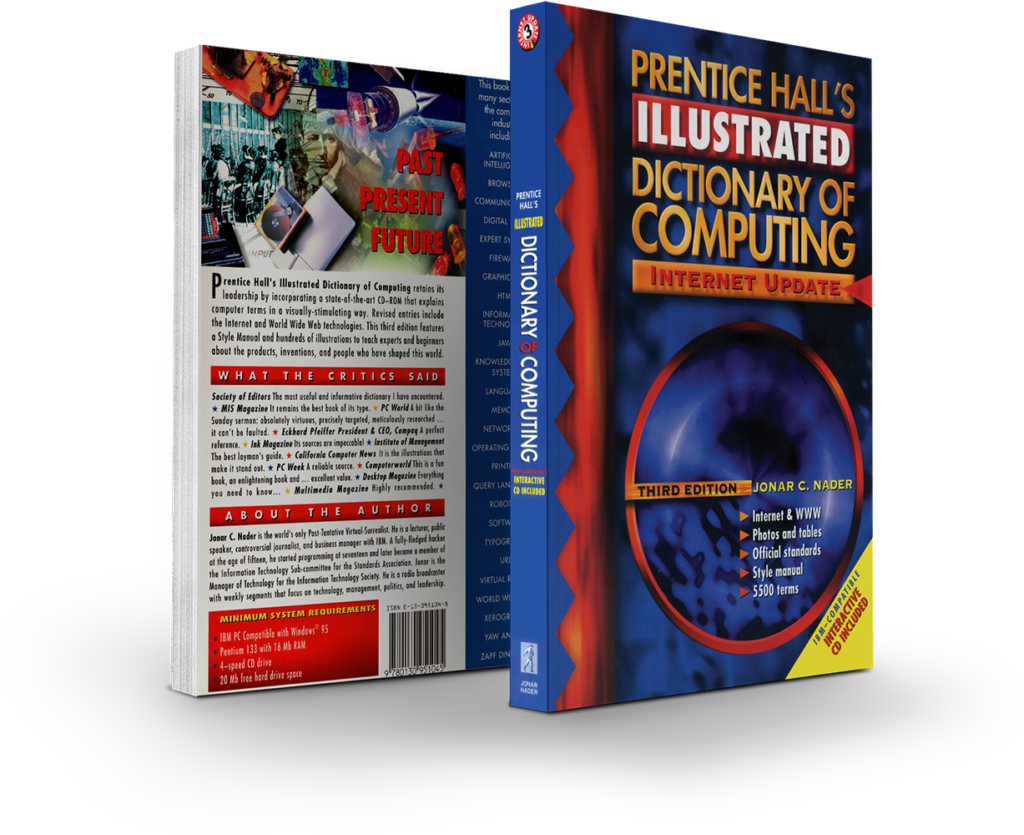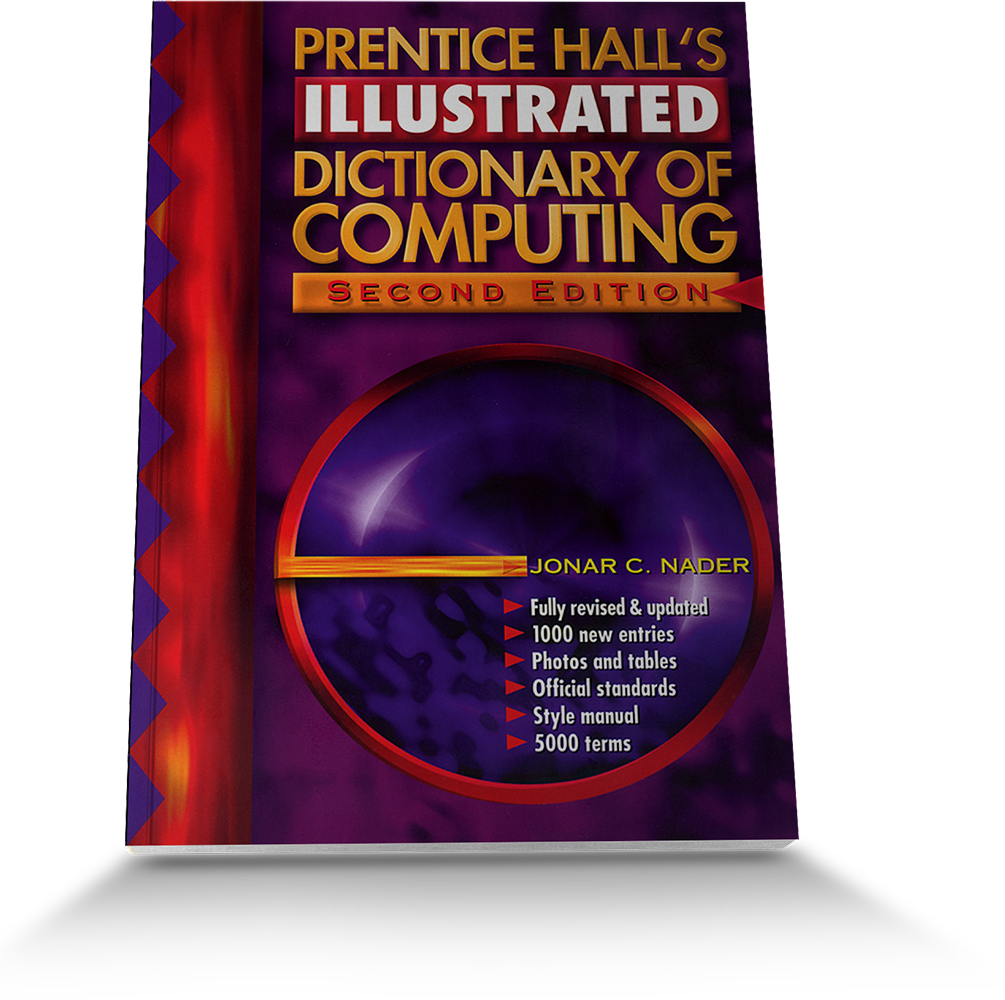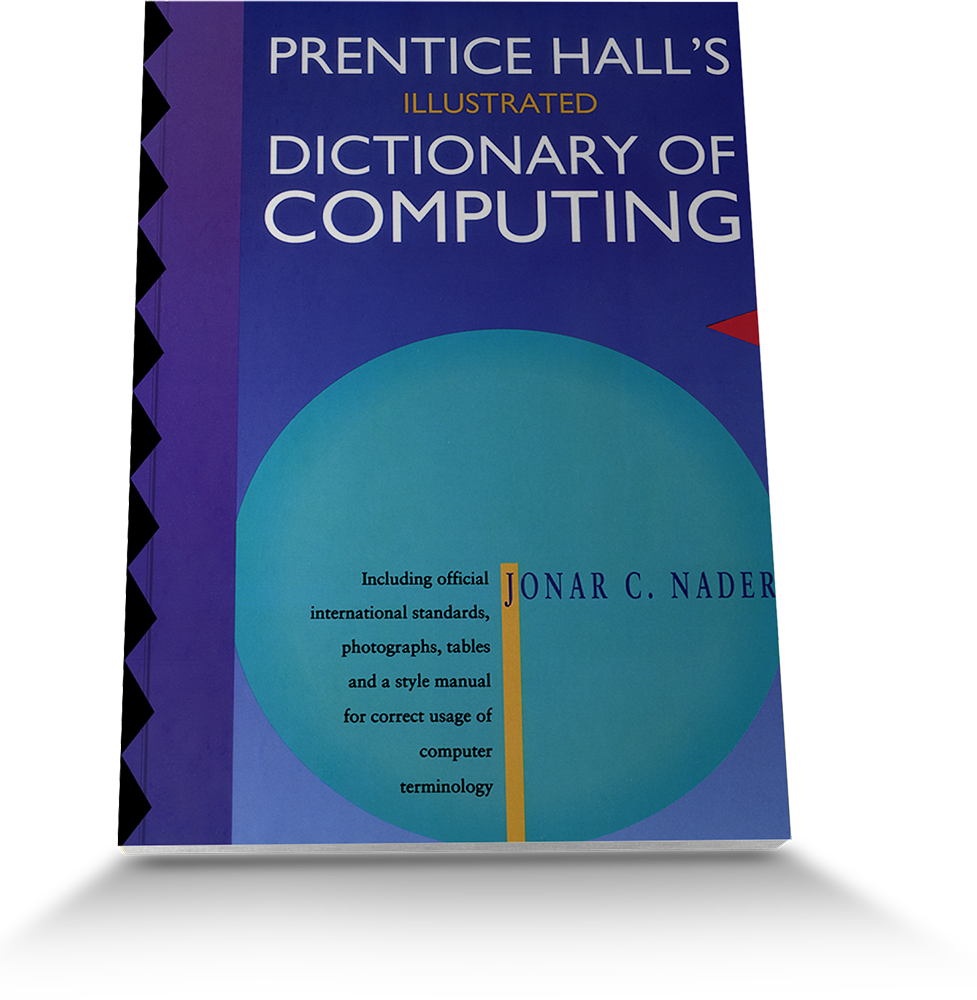PRENTICE HALL'S ILLUSTRATED DICTIONARY OF COMPUTING
(Third Edition)
By Jonar Nader
This book was the world’s first comprehensive and most extensive dictionary on the market.

Published by Pearson Education
795 pages, Paperback
ISBN 0 13 095104 8
Published by Pearson Education
795 pages, Paperback
ISBN 0 13 095104 8
This book was the world’s first comprehensive and most extensive dictionary on the market. It was also the first to incorporate international standards, and to include a style manual (for improved communication) and market data from IDC.
Following the success of the first and second editions, this fully-revised bestseller was exported internationally, including the United States, Canada, The United Kingdom, South East Asia, India, Japan, and New Zealand.
It was the first dictionary to recognise the need for international standards, and to work closely with the International Organization for Standardization (ISO) by including official terms defined by ISO and the International Electrotechnical Commission (both of whom are worldwide standardisation bodies).
Standards from other international bodies have also been taken into account, including the American National Standards Institute (ANSI); the Comité Consultatif International de Téléphonique (CCITT); and the Institute of Electrical and Electronics Engineers (IEEE).
What makes this dictionary unique?
This dictionary differs from others on the market in the following important areas:
- it offers explanations as to why certain abbreviations and acronyms are used
- where appropriate, the book give etymologies, correct abbreviations, acronyms, and contractions, and it shows how certain words should be pronounced
- it is accurate; taking into account current international standards and includes official terms defined by ISO (International Organization for Standardization) and IEC (International Electrotechnical Commission) which form the specialised system for worldwide standardisation
- it takes into account Greek, Latin, Arabic, French, and English origins to words; incorporating mathematical and scientific considerations
- it includes hundreds of illustrations, tables, diagrams, and photographs
- it covers a wide cross-section of the industry including hardware, software, connectivity, communications, word processing, desktop publishing, graphics, manufacturing, and robotics
- it does not assume that the reader is a technical expert
- it is enjoyable to read and offers interesting ‘snippets’ of information which make fascinating conversation pieces. Randomly-placed snippets include ‘Play on Words’ and ‘Newsflashes’ and ‘Fun Facts’
- it is enriched with industry analysis provided by IDC (International Data Corporation)
- it contains a special Style Manual to help the writer with usage and grammar.
Style Manual
This was the first (and still is the only) book of its kind to incorporate a Style Manual for correct usage of computer terminology. The Style Manual covers correct grammar, usage, ambiguity, numbers, capitalisation, international preferences, word breaks, currency, punctuation, and layout.
The Style Manual gives clear examples of correct and incorrect usage of computer-related terminology so that a reader can communicate more accurately.
Past, Present, Future
This dictionary covers a wide cross-section of the technology industry — explaining the past and the present, while exploring the future.
From around the world, over 500 people and 600 companies have helped the author to define over 6000 computer terms. This book highlights the historical aspects of the computer industry so that readers can learn about the products, events, discoveries, inventions, and people who have made a major contribution to the industry.
The book offers accurate and current information that will help its readers, whether they be technical experts or beginners. Entries describe the meaning behind the words, phrases, acronyms, and abbreviations used with present-day technology in a wide cross-section of business and industry.
So that readers can better understand the new directions in database management, microchip technology, robotics, fibre optics, and the use of satellites in information technology and communications, the book also explains the directions of technology in the areas of hardware, software, and programming languages and covers the Internet and the World Wide Web.
Jonar Nader calls for stabilisation in IT industry jargon
“There is nothing heroic about inventing one’s own abbreviation.”
At the launch of Prentice Hall’s Illustrated Dictionary of Computing, Jonar Nader, who was also the co-founder and President of the Australian Information Technology Society, called for stabilisation in the jargon used in the information technology industry.
In a plea to editors, Nader said that, for the sake of clarity and accuracy, the industry is now mature enough to stabilise on its style of jargon.
“Stabilisation in jargon does not mean that the language has to lose its colour. Nor does it mean that people cannot continue to develop the language. It simply means that writers, journalists, editors, and publicists ought to pay attention and respect to international standards and to the rules of grammar,” said Nader.
“It is important to realise that computer jargon is not a matter of fashion. It is troublesome enough that consumers are often confused by the jargon. Let’s not make matters worse by each having our own style of writing.
“The best and most controversial example is the ways in which various publications abbreviate the term ‘megabyte’. This term has been around for years, yet the industry still finds it acceptable to use dozens of different abbreviations for this simple term. For example, brochures and publications picked at random will show m; mb; M; mB; MB; MBs; M-byte; M-Bytes; Meg; MEG; M-B; and many other similarly-creative ways – all of which are incorrect. It is a little harder trying to differentiate these from the word ‘megabit’ (binary digit), where mb, mB, MB, and M-B are also used. A leading publication that erroneously uses ‘MB’ for megabyte, also writes ‘MBps’ to mean, quite confusingly, megabits per second.
“I have had many arguments with so-called experts who maintain that the term ‘megabyte’ in reference to software must be abbreviated differently to that which refers to hardware. What a load of nonsense! A kilogram is a kilogram, no matter what it measures,” exclaimed Nader.
Nader believes that industry leaders owe it to their customers to maintain a level of consistency. “Those who argue that the English language is a growing beast are right. However, there is no need to precipitate its deformity by refusing to observe international standards. There is nothing heroic about inventing one’s own abbreviation. There are very definite rules of grammar, Latin, Arabic, Greek, French, and English. These also incorporate mathematical and scientific considerations,” added Nader, whose dictionary makes a point of endorsing international standardisation.
An interview with the author, Jonar Nader
I have always been one for systems and standards. Not to the point where they stifle progress and imagination, but to the point where they assist in streamlining a process. Back in the 1980s, when I was heavily involved in the publication of technical material, I found it difficult to reach consensus about technical issues. Even experts and standards bodies all over the world contradicted each other on certain issues. I decided to carry out my own investigations with a view to publishing something accurate and authoritative.
Libraries and bookstores are full of various publications that try to broach the subject of computer terminology, but they do not adhere to standards. For example, if one were to consult 13 dictionaries (as I did) for the correct way to abbreviate ‘megabyte’, it would not be surprising to come across 13 different answers. The preface to some of these dictionaries often contained disclaimers like, ‘this glossary is merely a compilation of terms – it makes no pretence to being a standard’.
My dictionary is the first and only book to recognise the need for international standards, and to work closely with the United Nations’ International Organization for Standardization (ISO) and the International Electrotechnical Commission (IEC). My dictionary is also the first and only book of its kind to incorporate a Style Manual for correct usage of computer terminology.
I would say that the only other dictionary worth looking at is the Microsoft publication. However, its dictionary is specifically PC-oriented and it does not cover any other topic, making it limited in its scope. Furthermore, it does not subscribe to the level of accuracy as my dictionary does. Another important fact is that it is published by a major player in the industry – making it difficult for it to be an impartial publication. One will notice that it mainly covers products and terms that are of concern to Microsoft customers.
No. There is a big difference between a dictionary being ‘out of date’ and not ‘up to date’. Prentice Hall’s Illustrated Dictionary of Computing is as current as any dictionary can ever be. In some cases, company size and product ownership may vary. For example, in the first edition, I reported that the operating systems OS/2 was owned by Microsoft. The second edition was updated to reflect IBM’s ownership. However, the general nature of OS/2 did not change.
The first edition took four years to complete. The second edition took two years. Each week, I spent 20 to 30 hours of part-time work on the dictionary. When one adds the number of hours worked by the production staff and the hundreds of other helpers, it can be estimated that the total amount of time spent on the second edition exceeds 27 000 hours. By the third edition, which exceeded 800 pages, plus a CD-ROM, we have clock up over 40 000 hours to bring the most accurate and authoritative text on the market.
No. The first edition was hailed as the best of its kind. This set a standard that I had to exceed once again. The pressure was on to produce a publication that maintained its lead. It was more than just updating terms. The second edition had to cover the terminology that was in use at that time. The expectation by the publisher to produce another export-quality product made the second edition just as demanding as the first. The third edition had to continue that tradition, but open up a whole new layer with the Internet and World Wide Web, as well as update all the other thousands of entries.
I love the function of management and marketing because it is as exciting as the technology itself. I have been blessed with the capacity to function as a professional manager in an industry I thoroughly enjoy. People who try to consult about a product or service that they do not understand are in the same boat as those who know everything about a product or service, yet know very little about their market — both are doomed to fail. I make it my business to know about my total environment. Otherwise, I would be an ineffective management and technology adviser. The two are link together in this networked world of ours.
Excerpt from the Third Edition
‘The saddest thing is that to this day, visionaries still have to pay a high price for their foresight. Despite the marvels we have all witnessed, anyone who dares to predict the future is still ridiculed. In December 1994, I was laughed at for publishing an article that said, “In the short-term, the Internet will fail, only to resuscitate itself to attack once more. By then, hypernauts will be exploring new worlds, and ‘Internet II’ will find its way into every home and every office…
‘Interestingly, the Internet did fail for many. Those who knew where it was going managed to find their path and turn it into a useful tool. As predicted, while telepresence was demonstrated on marks in July 1997, the term “Internet II” which I was the first to use, became widely used and acknowledged.
‘In May 1995 I tabled the proposition that one day, operating systems will be a thing of the past — that their existence, as we know it, will become unnecessary. Though this seemed blasphemous, experts are beginning to realize that such notions are not as daft as they sound.
‘In keeping with my position as that of a futurist and technologist, and in line with the responsibilities I bear as the world’s only Post-Tentative Virtual Surrealist, I shall venture once more to suggest that the notion of “bits and bytes” is old hat. Why should a microprocessor have to suffer with the rigidity of a binary system? It’s not impossible; it’s just that it’s currently too complex to design such processors. When the decimal system, is given birth, a new era of computing will have emerged. “Bits” will become “dits”, while “bytes” will cease to exist. By then, digital devices will be passé. They will give way to more powerful analogue devices whose presence will force a re-definition of the legal meaning of life.’
What the critics said
It is a must for everybody’s library.
Hey Hey It’s Saturday, Channel 9
It’s an invaluable reference for anyone using a computer, whether you area a technical expert or a beginner, concerned with a mainframe or just a PC… it’s all there.
Alan Jones, Radio 2UE
It is the most useful and informative dictionary of computing I have encountered… it is a reference you are unlikely to outgrow.
Kevin Mark, Society of Editors
Nader’s book generally tended to have more information, more detailed and better explained entries … Nader’s book has a very useful Style Manual at the rear, which clearly explains the correct use of computer terminology. The Microsoft book has no such similar section.
Max Pinner, The West Australian
I wish I had written this book. And I use it frequently when I am answering readers who send me curly questions. The dictionary is strongly recommended to anyone who needs to get it right.
Gareth Powell, The Computer Report
Nader’s book gives you a great deal more information… and is therefore a worthwhile addition to your library.
Charles Wright, The Age
Computing jargon is amongst the world’s most colourful — and most obtuse — but help is at hand with the publication of Prentice Hall’s Illustrated Dictionary of Computing.
David Frith, The Sun Herald
Jonar has written a computer dictionary full of information definitely designed for people like me who know absolutely nothing about computers… it is accurate and informative with a light-hearted look at things so that the book is interesting, not only informative.
Pam Lawson, Radio 2RDJ FM
We find that there are many dictionaries on the market, but at last we have a new dictionary written by Jonar C. Nader. This dictionary has crossed the ‘T’ and dotted the ‘I’ as far as computer terminology is concerned, so that possibly any person can understand it and know how to use the computer with ease. Although, thank God, I consider myself one of the most experienced users, I can learn many things about computers by reading this book.
Anthony Wilson, El Telegraph
If discussion about megabytes, hard and floppy disks, mainframes and hot keys simply make your eyes glaze over, as I must confess they do mine even though I use computers, then a new book might be able to help you … I suggest that the person to whom we owe an enormous debt of gratitude for explaining all this is Jonar Nader.
Philip Clark, ABC Radio
A useful starting point for executives who have to wade through some of the terms being thrown at them by sales people and their computer departments.
Beverley Head, Financial Review
This is a fun book, an enlightening book, and excellent value. It’s well worth adding to your bookshelf.
Steve Ireland, Computerworld
Not just a very good dictionary, but compulsive browsing. An excellent choice for home and school libraries, it is authoritative and well written. Excellent value. An essential library acquisition.
Major Keary, Book News Newsletter
People in all sectors of business and education will find this book a perfect reference.
Eckhard Pfeiffer, President and CEO, Compaq
It does computer… Jonar Nader has hit the big time with an international printing of his book on computing.
District News
The dictionary is both up-to-date and accurate and covers computer terminology and correct usage in fields which include artificial intelligence, hardware, software, robotics, communications, expert systems, fibre optics and dozens of others.
Tanya Price, Times
Jonar Nader has just written the first book of its kind on computing. It is a world reference.
Chris Schofield, The Weekly Times
Some of its sources are impeccable!
Peter Coleman, Ink Magazine
Other editions

Prentice Hall's Illustrated Dictionary of Computing (Second Edition)
Accurate research figures and up-to-date industry analysis were essential ingredients in the preparation of this second edition.
Valuable information was afforded by the consultants and from the archives and libraries of IDC (International Data Corporation), which provided Jonar with a wealth of industry-specific intelligence gathered from the USA, Australia, and Europe.
Published by Simon & Schuster
691 pages, Paperback
ISBN 0 13 205725 5

Prentice Hall's Illustrated Dictionary of Computing (First Edition)
This was the first edition that started the successful series. It contains quotable quotes and fascinating industry insight. It looks at the people, the products, and the companies that made the industry what it is today.
Published by Paramount Communications
527 pages, Paperback
ISBN 0 13 719998 8
